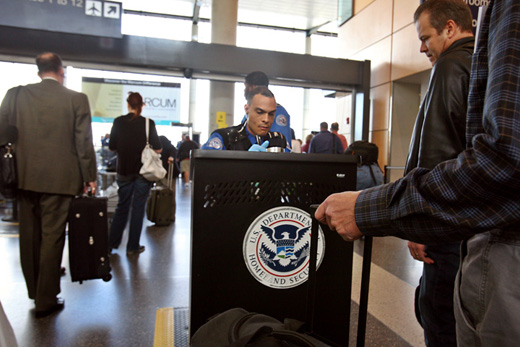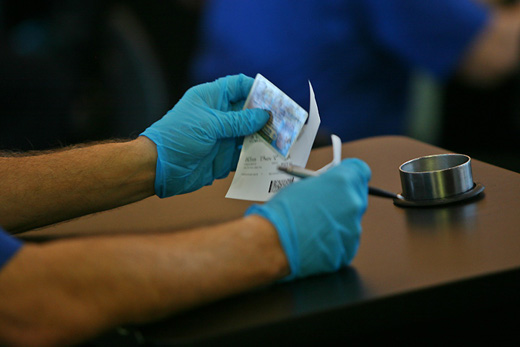TSA ID Checks : Security or Revenue Protection?
Over the course of the past few years, as travelers have experienced changes in the evolution of airport security procedures, the first layer everyone now experiences is the presentation of their valid government identification with their boarding pass.
While other countries have begun to implement boarding pass verification at the point a passenger begins the security process with the presentation of their identification and travel documents, the United States has not yet implemented this security layer.
The United States and Transportation Security Administration (TSA) have been at the forefront of attempting to push aviation security to new levels, but regardless of all other policies and procedures, the first level of security passenger encounter is in fact airline revenue protection … a role that the TSA is not tasked with.
At this time TSA Travel Document Checkers (TCD) are required to check a passenger’s name on both their identification and their boarding pass. TSA TCDs use a special flash light to ensure an identification is valid … they do not however check if a boarding pass is legitimate. Additionally, front line TSA TCDs do not have ‘watch lists’ or current names of those on the no fly list.
The problem with not checking if a boarding pass is valid is that an ‘online check in’ (OLCI) boarding pass that someone can print at home can easily be altered. Using an at home printed boarding pass allows for this scenario … someone on the no fly list purchases a ticket in another person’s name, at the time they check in online they save their online boarding pass as a PDF file, open PDF in Photoshop, alter the name, print one altered boarding pass and one non-altered boarding pass.
Upon arrival at the airport the person simply shows their boarding pass with their valid ID to the TSA TCD, since the boarding pass will not be validated, only the ID and then they proceed to the gate. When this person gets to the gate they present their non-altered boarding pass to the gate agent since gate agents only scan boarding passes, not a boarding pass and ID … they then board the flight.
Yes, the TSA has caught multiple people seeking to travel with fake identification … and while that is good for law enforcement seeking fugitives, or those who may be in the U.S. with a fake Visa, it is not the job of the TSA. To date none of the people the TSA has stopped attempting to fly with a fake ID were seeking to travel with explosives or with any intent to take over an aircraft.
Revenue protection is a significant issue for airlines, especially since no airline allows any to fly on a ticket purchased in another person’s name. The ability of airiness to change passengers rebooking fees, change of name fees, and a whole host of other fees associated with changing a ticket, this is a big issue.
… but … while airline revenue protection is a big issue for airlines, it is not an operational security issue for the TSA.
The Transportation Security Administration’s mission statement reads ” The Transportation Security Administration protects the Nation’s transportation systems to ensure freedom of movement for people and commerce.”
While some of the TSA’s current actions may be questionable regarding the ‘freedom of movement’ … there is nothing in the TSA’s core mission statement regarding the revenue protection of airlines … because protecting airlines revenue has nothing to do with actual safety and security of flights.
… and for those wondering if the above scenario is real, I can tell you that I have first hand knowledge of completely bogus boarding passes being used to cross through TSA checkpoints multiple times.
The TSA has continuously suffered from ‘mission creep‘ and as the agency has its feet to the fire presently, which will eventually cause the reevaluation of TSA’s role in various aspects of aviation security … it will need to justify the continuation of ID checks with boarding passes given that no terrorist will ever present a boarding pass that does not match an ID.
Presently the technology exists with Aztec Barcodes to verify boarding passes at all airport screening checkpoints. Aztec Barcodes are in use with mobile phone boarding passes … why not on paper boarding passes? Verifying a boarding pass is in fact real security.
Below are two photos of TSA TCDs I recently shot at Hartford/Springfield Bradley International Airport (BDL).
Happy Flying!




TSA was scanning all boarding passes, including cardstock and OLCI printouts at LAX T6 a few weeks ago.
But why should ID need to be presented at all? Why should identification have to be presented to travel internally in this country? The TSA should screen passengers for forbidden items, not play games with covert no-fly lists or act as revenue protectors for the airlines.
Matthew,
What you experienced at LAX is a limited pilot program. To date it appears to have only been performed on an inconsistent basis at LAX.
Names of those on the no fly list, or with other reasons to be stopped from flying at an airport, should be caught before a person gets to the airport during the DHS’ name checks against passenger lists. These lists are submitted to the DHS prior to flight by every airline.
… and yes, they should only be checking for prohibited items once in the screening area. No argument there.
Happy Flying!
-Fish
I believe one of our high courts (maybe even SCOTUS, but I don’t recall) has said that identification is NOT needed to fly in the United States as long as the passenger submits to secondary screening.
However, TSA doesn’t apparently feel that it is valid since they require ID anyway.
Jack,
You are correct. I have written about this here: Do You Need A Valid Photo ID To Pass Through TSA Security? Nope… – http://bit.ly/dD3F8Z
Happy Flying!
-Fish
For those with short memories or who are perhaps too young to know, there was no ID requirement for domestic flights until the early 90s. There was a consistent if limited pattern of people reselling non-refundable tickets, or selling their frequent-flyer tickets. The airlines were furious about this and wanted to stamp it out. They wailed that flying under an assumed name was illegal (it wasn’t). They tried and tried but the public wouldn’t accept a requirement to present id at the gate, and if any one airline had tried to force the issue itself, people would simply have flown on another airline.
Then TWA flight 800 blew up. The ID requirement was enacted within days. Investigation proved it was not a terrorist event, but no matter. The airlines had got what they wanted — no competitive disadvantage — because the FAA had now mandated it for all airlines across the board.
Fish-
Serious question for you. If I dont want to subject myself to the AIT machine, and am given an “enhanced” pat-down, what is stopping me from tucking my stuff between my legs and getting the patdown? would i be breaking any laws?
Triple OG says… Fish, I believe it was Theodore Kacynkski (a.k.a. the Unabomber) who was responsible for the requirement of the airlines that all ticketed passengers show government issued Identification…. So, in a way, we can thank MKUltra and the CIA for this….